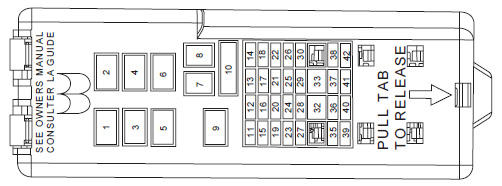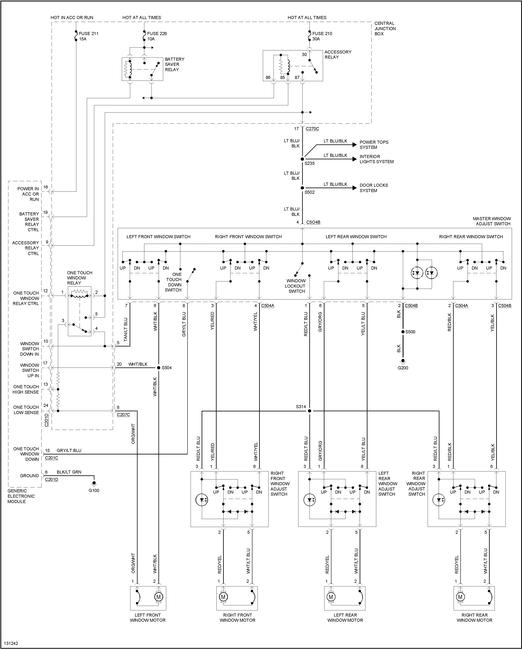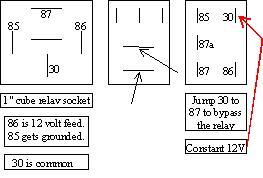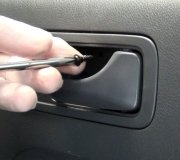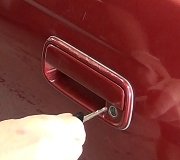Before we get all wrapped around the axle looking for hard stuff, there's a couple of things to consider that I've seen stump some really experienced mechanics. Rather than fall victim to these traps, and so I have confidence in our diagnosis, my first concern is using a digital voltmeter. For this type of problem, a cheap test light will be more accurate.
"I checked for continuity at the switch to the big connector near the door hinges, it had continuity"
This tells me you have more knowledge of electrical diagnosis than all do-it-yourselfers and most mechanics, but keep in mind that frayed and broken wires between the door hinges account for probably 99 percent of power window and lock problems, but all you need is one remaining strand of wire for the ohmmeter to see a "complete" circuit, meaning no breaks in it. To make it even more distressing, if you're measuring voltages, which is faster then testing individual wires except as a verification test, you can have a totally broken wire, but if there's a carbon track left behind where arcing took place across that break, that carbon will conduct plenty of current for a digital voltmeter to pick up a voltage. That is REAL common when a fuse link wire burns open but it can happen in regular wires too. In this case you wouldn't find 0 ohms on that wire, so that's where my comment about a single remaining strand comes in. That strand will result in reading 0 ohms on that wire, but you won't get enough current through it to run a window motor. The faster method here would be to find 12 volts at the switch, until you turned the switch on and current tried to. Flow, then all that voltage would be dropped across the break and you'd see your voltage at the switch go real low or to 0 volts. The test light does something similar. It needs to draw substantial current to work and it can't do that when there's only a carbon track across a break in a wire. The voltmeter can still falsely read a voltage but the test light won't.
The next concern that you likely didn't do, but I don't want to overlook something stupid, is you used the door skin for ground. The hinges don't make good contact and usually there is nothing grounded to the door. All the ground circuits go through a wire between the door hinges, and are grounded inside the body. To be accurate, anything that requires your meter to be grounded has to have it grounded on the main body.
Related to this, if you're looking for 12 volts across the two motor terminals, for example, you obviously won't read 12 volts if the 12 volt feed wire is open, but the same is true if the ground wire is open. You could have multiple broken wires, and that's typically what you'll find when one is bad.
A third thing to keep in mind is you did the testing while the door was open and wires were being tugged on. It's common to find a window or lock is dead only when the door is in certain positions. That's a sure-fire clue the cause is wires.
Related to ground circuits, this was always a great and wondrous revelation to my students that made these really complicated wiring diagrams easier to follow. When the window switches are released, you will find one 12 volt feed wire to each one, then every other wire will read 0 ohms to ground, AND both motor wires will read 0 ohms to ground. This applies to standard, common window circuits that don't incorporate additional relays to do the switching. (I can't read the diagram you found well enough to tell if relays are involved). What happens is there's four sets of contacts in each window switch. Each motor wire goes through one set, then to ground. Remember, this is when the switch is released.
When the switch is activated, one contact remains grounded like before and continues to provide the ground circuit for the motor, BUT, ... The other contact is moved by the switch handle to first break the contact to ground, then apply it to the 12 volt supply. This gets more complicated for the three passenger windows because they have a second switch. Those ground circuits go through all the contacts in both switches. Either switch can remove one ground contact and apply 12 volts to it, depending on which way you want the motor to run.
At this point my head is starting to spin so I'm going to take a break and let you verify your test results. Relays cause very little trouble, but if you want to insure yours isn't the cause of the missing 12 volts, you can jump terminals 30 and 87 together with a stretched-out paper clip or piece of wire. That will also give you easy access to a test point to make sure you have 12 volts there. The next suspect point is a corroded splice where the circuit branches off to feed the interior lights. (I guess I CAN read that schematic). Next comes the splice for the power locks. If the power locks work, you know everything in the circuit is okay up to that point. From there you basically have the wire between the door hinges.
Image (Click to make bigger)
SPONSORED LINKS
Wednesday, October 29th, 2014 AT 10:05 PM
